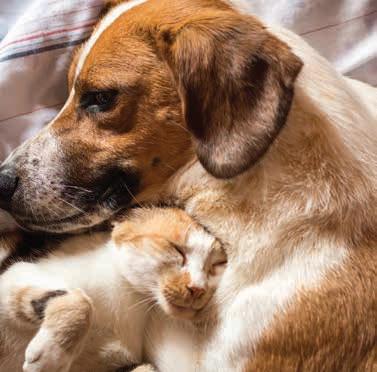
7 minute read
THINGS TO DO BEFORE YOU ADOPT A PET
So you’ve made the decision to get a dog or cat. Hooray! Pets are a lot of fun to play with and can be exceptional cuddling partners. In short, they are fantastic companions and even incredible support when we feel depressed and anxious (we’re looking at you, 2020...).
A dog or cat is a multi-year commitment of care, which includes ensuring their safety, feeding and housing them, and keeping them healthy. Yep, there’s a lot to know. So let’s get you ready to bring home your new furry family member.
Advertisement

1. Prepare Yourself and Your Family
Before you take the leap of adopting a new pet, you might consider fostering a dog or cat from a local shelter. Our friends at PetFinder make it easy to find local pet shelters so you can find out about fostering as well as find that new family member to adopt. Find a pet that fits your family and lifestyle. You need to ask yourself (and the people you live with!) how will a dog or cat fit into our life?
• Are you an outdoor enthusiast and want to take your best furry bud with you? Find a dog that will be able to take long hikes, sleep in a tent, hang out in the canoe. Sometimes you can train a cat to do these things too, but we don’t recommend it as a starting point!
• Do you live in a small space, like an apartment? A smaller breed of dog or a cat might be easier to live with.
• Are you away from home all day? Some breeds of dogs have eparation anxiety, especially those that end up in shelters. The last thing you want is to learn from your neighbors that your dogs is whining and barking all day while you are gone.
• Do you like a lot of quiet time? A cat, who will likely be very independent, might be the perfect new companion.
Think about the life you live now and how your new dog or cat will fit into it and what changes you will have to make to accommodate this new family member. Here are a few things to consider when choosing a new pet:
• Energy Level - of you and the pet
• Size when fully grown
• Relating to other animals and children
• Noise level of the pet
Ensure everyone knows who is responsible for the care of your pet. If it’s just you, make sure you are ready to handle everything on your own.
• Who will feed them?
• Who will clean-up after them?
• Who will check in on them during the day?
• Who will ensure they get lots of daily exercise?
2. Spend Time With Them Before You Bring Them Home
Go to the shelter or breeder and meet the dog or cat you want to adopt. Shelters now can offer a lot of information about the animal, but it is not a replacement for actually spending time with them in person. If possible, schedule a time to go to the breeder or the shelter and play with the dog or cat you researched online. It’s also smart to ask the staff at the shelter about the animals you are meeting. They will know more about their personality and temperament as well as any history you need to know. Spending time with them in advance gives you a chance to see if they warm up to you as well. Remember, this is a multi-year relationship that will grow from this first meeting into a deep, loving bond. It’s worth taking the time to ensure it’s a good fit for both of you.
3. Set Up a Space Just For Them
Once you have made the decision to adopt and found your new four-legged family member, it’s time to get ready to bring them home. Your home will be a completely foreign place for them, so carve out some space just for them.

For a dog, set up a crate that can become their special space that includes a bed, blanket, and toys
For a cat, set up a small, enclosed area that includes their litter box and fresh litter, food and water, and perhaps a bed, even though they will likely assume anyplace they sleep is “their” bed.
Be sure to include something from the shelter or breeder to put into that space as well. Something that smells familiar will help them settle into this strange new space called your home. You can also use a pheromone wall plug-in to help keep them calm while they settle in.
4. Pet Proof Your Home
This is a temporary step while you orient your new pet with your home. Puppies are notorious for chewing up anything within their reach. And cats love to explore and, well... knock things off counter tops. So... decide where you DON’T want them to go and close off that part of your home. You can introduce them to these areas after they get settled.
Put away cleaning supplies and poisons in places they cannot access. And remove valuables and small items they can choke on or will find too enticing to leave alone. Slippers, shoes, socks, eye glasses and anything that smells like you is fair game for your new furry pal.

Buy them their own doggie chew toys and catnip stuffies to chew on and train them to stay away from chewing on your socks and pens.
5. Find a Local Veterinarian
You should plan to schedule your pet’s first visit right away. The shelter will be able to tell you what vaccines they have had and when their next shots are due. They will also be able to tell you if they have any health issues. Choosing a vet is a very personal thing, like choosing your doctor. Think about what kind of experience you want for yourself and your furry pal.
If you like a bigger vet clinic with a more well known name, you may find it easier to get an appointment, but may not know the vet who will meet with you. If you prefer to make a relationship with one vet, find a smaller clinic nearby.
Consider asking your friends and family what vets they like. Pet parents, like human parents, have passionate opinions about the care of their family members and will likely give you an honest assessment of their experience.
6. Look Into Pet Insurance
The average person spends between $300 and $400 per year on their pet’s care. This doesn’t include veterinary visits, which can add cost anywhere from $200 for a check up and to $5,000 for treatments and surgeries. Pet insurance, while not widely known in the US, is an excellent way to lower the cost of caring for a pet. Plans range from about $10 per month for plans with less coverage to $80 per month for more comprehensive plans. One of the main benefits of pet insurance is to help pay for unexpected illness or injury, which can quickly become very expensive. Our friends at Pawlicy have a terrific blog post that outlines the pros and cons of pet insurance from a veterinarian’s perspective. Keep in mind that you are looking for the best plan to save you money and ensure your new furry family member gets care when they need it without hurting your wallet. Investopedia and Consumer Advocates also offer excellent comparisons of the top pet insurance companies in the US.

7. Plan to Introduce Them to Other Pets
Introducing your current pet to your new pet is a very important part of your planning process. Rather than fill this guide with how to navigate this with both dogs and cats, we have gathered the best information we could find for your specific situation.

Introduce A Cat To Another Cat
8. Find a Good Dog Trainer
Conventional wisdom suggests that dog training is actually designed to train the people in the dog’s life to communicate well with the dog. This makes a lot of sense as your goal with a trainer is to understand what your new furry family member needs, wants, and is trying to communicate with you. And, when successful, helps the pet know where they fit in the pecking order in the household. Training is an ongoing process that continues after the classes end. Just like with a kid who is constantly pushing boundaries, a pet that is allowed to run wild, will eventually learn that this is the norm and happily continue this behavior.
Another important aspect of training is that it must include every human who lives in the house, especially children, who must find a way to communicate with your pets so the pet listens to them as well. How will you find a trainer near you? We’re so glad you asked! Check out:
• Bark.com has listings for all things local, even local dog training
• The Association of Professional Dog Trainers has an extensive list of trainers
• The Certified Council for Professional Dog Trainers has lots of resources lots of training resources
• Thumbtack has listings for local dog trainers too!
WHAT ABOUT CAT TRAINING?
Although it is believed you can’t train cats, we found some resources that prove otherwise from Hill’s Pet Nutrition offers a variety of cat training tips and Daily Paws that shares 7 essential commands you can teach your cat.
9. Learn... Learn... Learn
There is a good reason Millennials refer to pet ownership as training for children. Caring for another being, be it furry or human, is a multi-year, deep commitment that requires learning... and more learning. Since this list is long and full of detail, bookmark this page and come back to it.
We also have listed below the resources we went to as we researched this article. You should read them too. The more you know, the better your life with your new pet will be.
10. Be Patient With Yourself!
You will likely make lots of mistakes in your first days and weeks with your new dog or cat. You are all adjusting to living in the same house and creating a new rhythm together. If things go sideways, refer back to articles just like this one. Ask your pet parent friends and family how they settled into a routine with their furry family. And be patient with yourself. You will find your way together.
We strive to collaborate with dedicated clients, professional builders, talented consultants, and budget mindfulness…to navigate the vision of a project, the design and documentation process, the completion of permitting, and the process of construction…to create a project that embodies that vision.



















